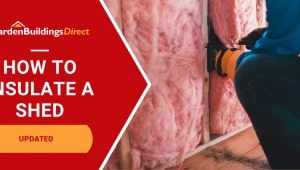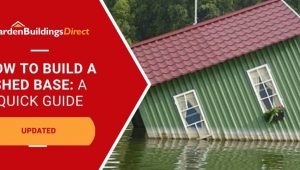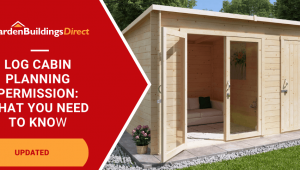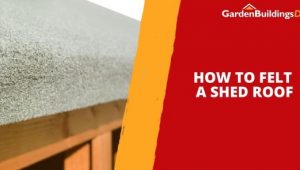Jump to:
A garden shed is always handy to have, but it will only serve its purpose if it stays dry. Even small leaks can cause headaches, which is why waterproofing goes a long way. Here’s a straightforward look at what to do and how to keep your shed in good shape, based on the issues we see most often on older sheds.
Why Waterproofing Your Shed Is Essential
Wooden structures simply don’t get on with moisture. Prolonged water exposure can lead to rotten timbers, damaged walls, swollen doors and rusty tools. On sheds that have been in place a few years, the first signs are often subtle: a slightly spongy floorboard by the door, a dark patch on the inside of a wall, or a faint musty smell. By the time you can see obvious rot, it’s usually been wet for a while.
It’s best to deal with problems before rainwater gets a chance to do real damage. A quick check after bad weather can save you the cost of major repairs or a replacement later.
Note: Even in drier parts of the country, moisture still poses a risk. Every area gets some rain, and even light showers can cause trouble for a timber shed if water is allowed to sit around the base or creep in through gaps..
How to Waterproof a Wooden Shed
Waterproofing your shed isn’t as tricky as it sounds, and you can definitely do it yourself. The steps below follow the same order we advise customers to use for their maintenance: start from the ground up, then work your way to the roof and interior.
Check the base
Start at ground level. A large number of damp problems we see come from sheds sitting too low or directly on the ground.
Is the shed sitting straight on soil, grass or tarmac? If so, it’s far more prone to rising damp and insect problems. The easiest way to protect it is to raise it on a base. You can build one yourself (timber frame or slabs with bearers), or buy a good-quality wooden base designed for your shed size.
A concrete base works very well, as long as the shed floor sits on timber bearers or a sub-frame so air can circulate underneath. There should be a visible gap under the cladding, not boards sitting tight to the slab.
Paving slabs can work too, but avoid dropping the shed straight onto a flat patio where water puddles around the edges. Either run bearers under the floor or choose a slightly raised, well-drained slab base where water can run off.
If you notice damp staining or green algae around the bottom boards, that’s a sign the base isn’t draining well enough and needs attention.
Clean the gutters
Gutters help to prevent water from cascading off the roof and splashing your shed’s lower timbers. However, if they become blocked, then you’ve got the problem of water pooling on the roof, which can lead to leaks.
Clear leaves, moss and debris from gutters so they drain freely, check that the downpipes are clear, and consider collecting rainwater in a water butt.
Check windows and doors
We often find that leaks start around openings rather than through the middle of a wall panel. Over time, timber shrinks and gaps can appear around windows and doors. Even hairline cracks can let wind-driven rain in.
Here’s what to do:
- Inspect after rain:
Look for dirty tide marks or darker patches below windows and around the door frame inside the shed. - Seal small gaps:
- Use an exterior-grade caulk or frame sealant for fine cracks.
- Draught excluder tape works well where the door doesn’t quite meet the frame.
- Expanding foam can be used for larger, hidden cavities, but trim it back and cover it with trim or sealant so it’s not exposed to sunlight.
- Deal with any rot:
If you find soft timber:- Cut or scrape away the loose, rotten wood.
- Treat the exposed area with a wood hardener or preservative.
- Build it back up with exterior wood filler, sand smooth, then repaint or re-stain.
Catching minor gaps early stops a lot of the “mystery” drips people notice months later.
Protect the roof
The roof takes the worst of the weather, so it’s usually the first place problems show. Start by checking the covering (felt, shingles or a membrane) at least once a year, and always after strong winds. Look for blisters, loose nails or tacks, curling edges and any tears, especially along the ridge, corners and overhangs. If you can safely get inside the shed during daylight, look up for pinpricks of light or damp patches – these often reveal hidden leaks.
Small splits or nail holes can usually be patched. Brush away any dirt, dry the area, then seal it with a suitable roofing adhesive or sealant and cover with a patch of matching felt or membrane, making sure it overlaps well onto sound material. If you notice larger areas of damage, widespread blistering, or felt that’s become brittle, it’s more effective to strip it off and recover the roof completely. Fresh shed felt, a modern waterproof membrane or a single sheet of EPDM rubber will all give long-lasting protection when fitted correctly, helping to keep the roof boards and the rest of your timber structure dry.
If you notice widespread blistering or cracking, felt that’s become thin and brittle, or multiple patches close together, it’s usually more effective (and longer-lasting) to strip the roof and re-cover it completely.
Fresh shed felt, a modern waterproof membrane or a single sheet of EPDM rubber will all give long-term protection when fitted correctly and fixed down well along the edges. A good roof job is one of the biggest upgrades you can give an older shed.
Treat the wood
On sheds we see that have “suddenly” gone rotten, the exterior coating has usually been left far too long.
Regular shed treatments help keep moisture out and extend the life of your timber. Water-based stains or paints dry quickly and help keep damp out. They’re also less toxic, which is handy if you’re working on your own. Make sure you have space to move around the shed so the preservative can be applied evenly.
Learn more:
Shed Maintenance: Treatments and Refurbishing
Insulate and ventilate
Inside moisture is just as common as rain coming through the walls. We often see sheds with perfectly sound cladding but mould on the contents because there’s no ventilation. Good airflow helps stop damp from building up inside, and insulation reduces the ability for moisture to condense.
For most timber sheds:
- Install at least two vents on opposite walls to create a cross-flow of air.
- Place them high up, just below the roofline, where warm, moist air gathers.
- On larger sheds, a pair of high vents and a pair of lower vents (near the floor, but above splash level) works well to encourage circulation.
- Ridge vents are useful on bigger garden rooms or workshops with a long ridge line.
- Use bug-proof or louvred vents to keep insects and debris out.
Try not to block vents with shelves or stored items – leave a clear space so air can actually move.
Shed Ventilation: How-to and Things to Consider
How to Spot Leaks and Damage in Your Garden Shed
The easiest way to spot problems is after it’s rained. You’ll notice damp patches on the walls, a bit of discolouration, or maybe some of your stuff has got wet. When that happens, follow the water back to see where it’s coming from.
While you’re at it, give the shed a good once-over for any cracks in the wood or damp coming through the floor. Even tiny cracks can turn into bigger problems if left alone. Deal with any damage while you spot it; otherwise, you’ll be chasing leaks later.
When it’s time to replace your garden storage, make it easier on yourself and pick something that will last. Take a look at our shed buying guide by clicking the button below.
Garden Sheds Buying Guide




